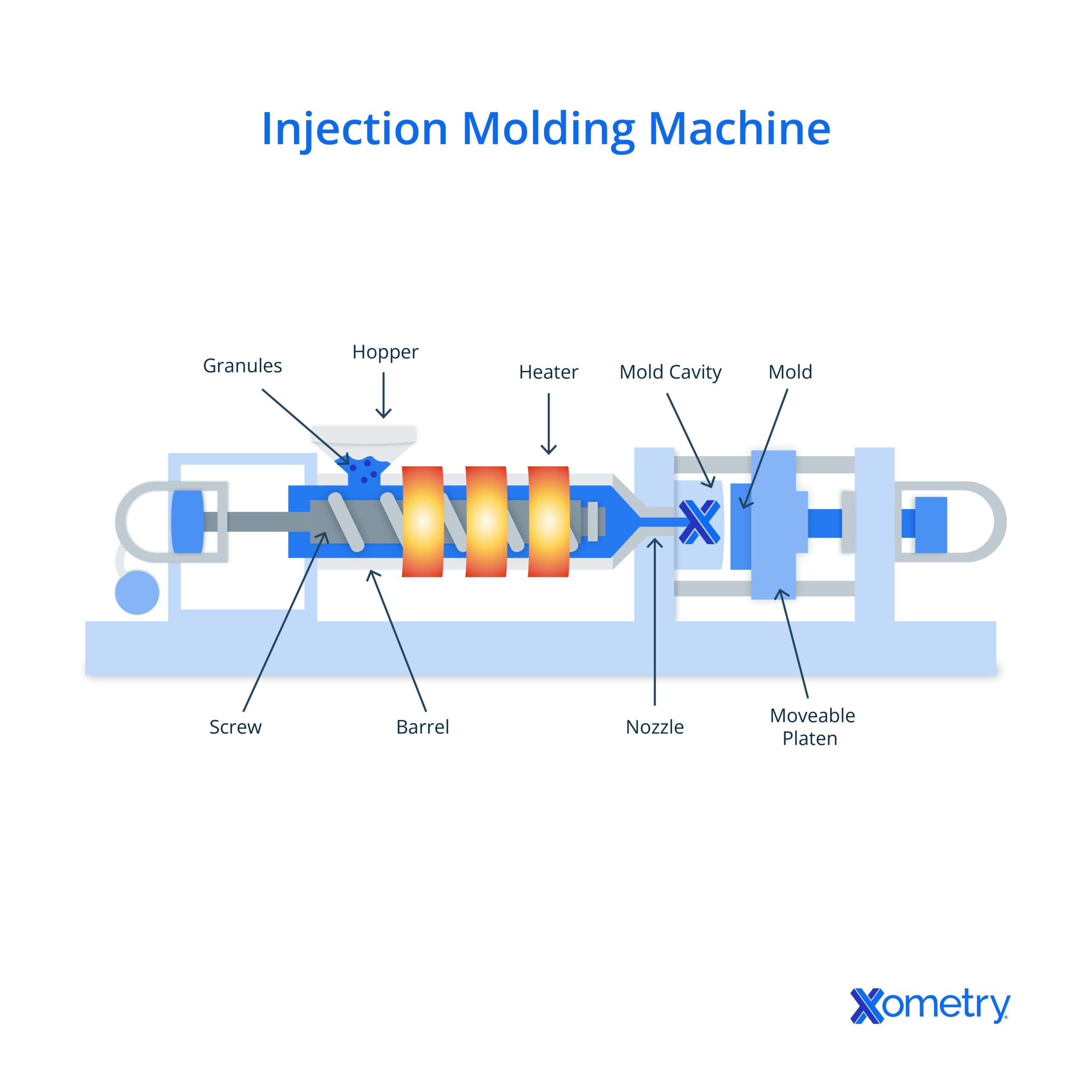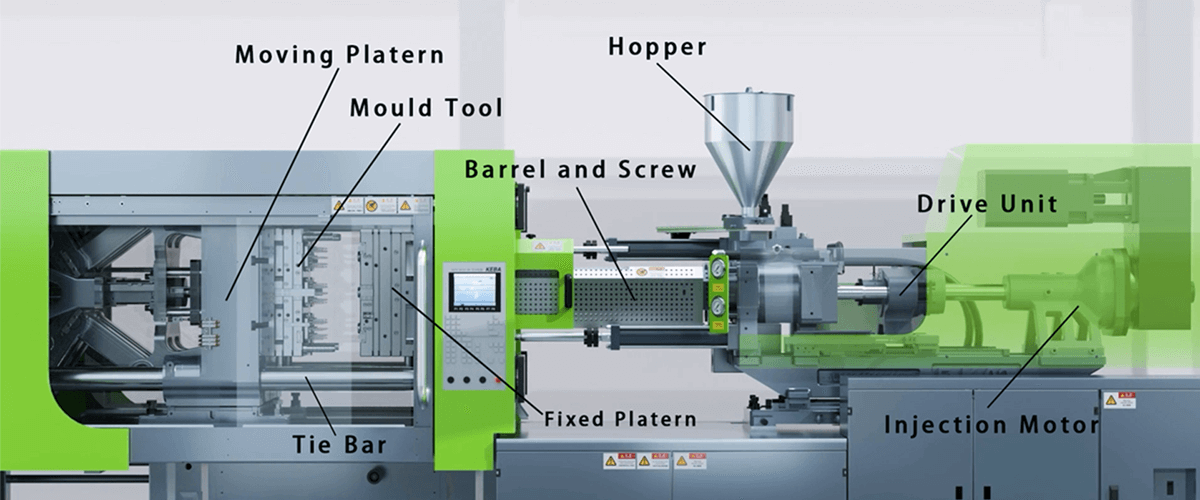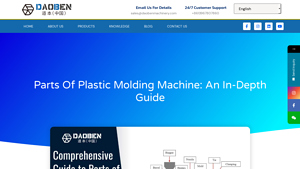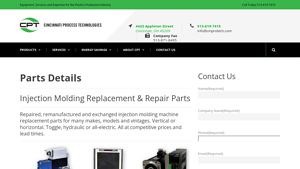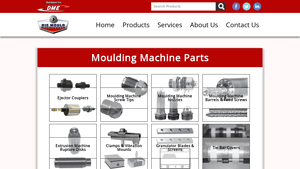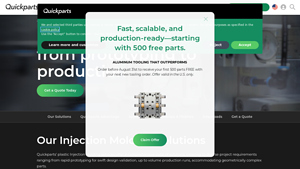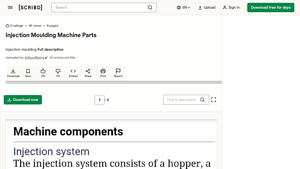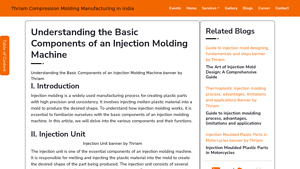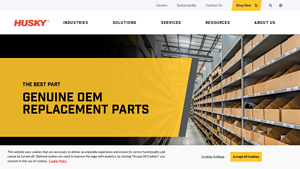Injection Molding Machine Parts Guide: Type, Cost, Top List…
Introduction: Navigating the Global Market for injection molding machine parts
Navigating the complexities of sourcing injection molding machine parts can be a daunting challenge for international B2B buyers, especially those operating in diverse markets like Africa, South America, the Middle East, and Europe. With a plethora of components ranging from hoppers and barrels to nozzles and ejector pins, understanding the intricacies of each part is crucial for ensuring operational efficiency and product quality. This guide aims to empower buyers by providing a comprehensive overview of the various types of injection molding machine parts, their applications, and the critical factors to consider when selecting suppliers.
In addition to detailing the essential components, this resource will explore the process of vetting suppliers to ensure reliability and quality, the cost implications of different parts, and strategies for optimizing procurement. As businesses increasingly seek to streamline operations and reduce downtime, having access to accurate information about injection molding machine parts becomes invaluable. Whether you’re a manufacturer in Vietnam looking to enhance production capabilities or a distributor in Brazil aiming to expand your offerings, this guide equips you with the insights needed to make informed purchasing decisions. By understanding the global market dynamics and the latest trends in injection molding technology, you can enhance your competitive edge and drive growth in your business.
Understanding injection molding machine parts Types and Variations
| Type Name | Key Distinguishing Features | Primary B2B Applications | Brief Pros & Cons for Buyers |
|---|---|---|---|
| Reciprocating Screw | Features a rotating screw that injects and mixes plastic | High-volume production of plastic parts | Pros: Efficient mixing, consistent heating. Cons: Higher initial cost. |
| Ejector Pins | Used to remove molded parts from the mold | Automotive, consumer goods, and electronics | Pros: Ensures clean ejection, minimizes damage. Cons: Requires regular maintenance. |
| Split Molds | Consists of two or more parts that form a cavity | Complex shapes and detailed parts | Pros: Versatile for different designs. Cons: More expensive and complex to manufacture. |
| Nozzles | Directs molten plastic into the mold | Custom and high-precision molding applications | Pros: Enhances flow control, reduces waste. Cons: Can clog if not maintained properly. |
| Heating Elements | Maintains temperature for melting plastic | Suitable for various thermoplastics | Pros: Ensures consistent melting. Cons: Can require replacement over time. |
What Are the Characteristics of Reciprocating Screws in Injection Molding Machines?
Reciprocating screws are integral to modern injection molding machines, providing the dual function of melting and injecting plastic materials. They feature a helical design that allows for efficient mixing and uniform heating of the plastic. This design is particularly suitable for high-volume production, making it a preferred choice for manufacturers looking to optimize their output. Buyers should consider the initial investment and maintenance costs, as well as the potential for increased efficiency in production runs.
How Do Ejector Pins Function and What Are Their Key Benefits?
Ejector pins are critical components in the mold ejection process, ensuring that molded parts are removed without damage. They are strategically positioned to push the finished product out of the mold after cooling, reducing cycle time and improving product quality. In B2B applications, such as automotive or consumer goods manufacturing, the reliability of ejector pins can significantly impact production efficiency. Buyers should evaluate the durability and maintenance requirements of ejector pins to ensure long-term performance.
What Makes Split Molds a Preferred Choice for Complex Designs?
Split molds are designed to create intricate shapes by utilizing two or more sections that form a cavity when closed. This type of mold is versatile and can accommodate various design specifications, making it ideal for complex parts in industries like electronics and automotive. While they provide flexibility and precision, split molds can be more expensive and complicated to manufacture. Buyers should assess their design needs against the cost and complexity of split molds to determine suitability.
Why Are Nozzles Essential in Injection Molding?
Nozzles play a vital role in controlling the flow of molten plastic into the mold, ensuring precise delivery and minimizing waste. They can be equipped with various features, such as shut-off capabilities and mixing functions, which enhance the quality of the final product. In B2B applications, particularly in custom and high-precision molding, the choice of nozzle can significantly affect production outcomes. Buyers should prioritize nozzle design and compatibility with their specific materials to maximize efficiency.
How Do Heating Elements Contribute to the Injection Molding Process?
Heating elements are crucial for maintaining the proper temperature during the melting of plastic materials. They ensure consistent heating, which is essential for producing high-quality molded parts. Various types of heating elements, such as band and cartridge heaters, are available for different applications. Buyers should consider the specific thermal requirements of their production processes, as well as the longevity and maintenance needs of heating elements, to ensure seamless operation and cost-effectiveness.
Key Industrial Applications of injection molding machine parts
| Industry/Sector | Specific Application of Injection Molding Machine Parts | Value/Benefit for the Business | Key Sourcing Considerations for this Application |
|---|---|---|---|
| Automotive | Production of interior and exterior components | Reduces manufacturing costs and enhances product durability | Ensure compatibility with high-temperature materials and precision specifications. |
| Consumer Electronics | Creation of housings and internal components | Streamlines assembly processes and improves product aesthetics | Focus on high-quality materials to meet safety and compliance standards. |
| Medical Devices | Manufacturing of surgical instruments and medical packaging | Ensures product reliability and compliance with health regulations | Source from suppliers with certifications for medical-grade materials. |
| Packaging | Development of containers and closures | Increases shelf life and enhances product protection | Consider suppliers with capabilities for custom molds and rapid prototyping. |
| Construction | Production of fixtures and fittings | Improves efficiency in assembly and reduces labor costs | Look for suppliers with experience in durable materials suited for harsh environments. |
How Are Injection Molding Machine Parts Used in the Automotive Sector?
In the automotive industry, injection molding machine parts are integral in producing a variety of components, such as dashboards, bumpers, and interior trim. These parts are designed for durability and can withstand the rigors of automotive applications, helping manufacturers reduce costs and improve the longevity of their products. Buyers in this sector should ensure that the parts sourced are compatible with high-temperature materials and meet stringent automotive standards.
What Role Do Injection Molding Machine Parts Play in Consumer Electronics?
In consumer electronics, injection molding machine parts are utilized to create housings and internal components for devices like smartphones and laptops. This application streamlines the assembly process, allowing for quicker production times and improved aesthetics. International buyers should prioritize sourcing high-quality materials that comply with safety and compliance standards to ensure consumer safety and product longevity.
Why Are Injection Molding Machine Parts Critical for Medical Devices?
The medical device sector relies heavily on injection molding machine parts for the production of surgical instruments, implants, and packaging. These components must meet strict regulatory standards, ensuring reliability and safety in medical applications. Buyers should seek suppliers who can provide certifications for medical-grade materials, as well as expertise in producing complex parts that meet specific health regulations.
How Do Injection Molding Machine Parts Enhance Packaging Solutions?
In the packaging industry, injection molding machine parts are essential for developing containers and closures that protect products and extend shelf life. The precision of injection molding allows for the creation of custom shapes and designs that improve functionality. Buyers should consider suppliers who can offer custom molds and rapid prototyping services to meet unique packaging needs.
What Benefits Do Injection Molding Machine Parts Offer in Construction?
In construction, injection molding machine parts are used to manufacture fixtures, fittings, and various components that enhance building efficiency. These parts improve assembly processes and reduce labor costs, making them valuable for construction projects. Buyers should seek suppliers with experience in durable materials that can withstand harsh environmental conditions, ensuring long-lasting performance in construction applications.
3 Common User Pain Points for ‘injection molding machine parts’ & Their Solutions
Scenario 1: Difficulty in Sourcing Quality Injection Molding Machine Parts
The Problem:
B2B buyers often struggle with sourcing high-quality injection molding machine parts due to a fragmented supplier market. In regions such as Africa and South America, where local manufacturing capabilities may be limited, buyers face the challenge of identifying reliable suppliers who can provide original equipment manufacturer (OEM) parts. This issue is compounded by concerns about counterfeit parts that can lead to machine breakdowns, increased downtime, and ultimately, loss of revenue. Buyers may also find it difficult to navigate the technical specifications required for their specific machinery, leading to mismatched parts.
The Solution:
To effectively source quality injection molding machine parts, buyers should establish partnerships with reputable OEM suppliers who offer transparent information about their product lines. Conducting thorough due diligence on potential suppliers is essential. This includes checking their certifications, quality assurance processes, and customer reviews. Utilizing platforms that specialize in B2B transactions can also streamline the search for reliable suppliers. For instance, engaging with industry-specific marketplaces or supplier directories can provide insight into the best sources for high-quality parts.
Buyers should also invest time in understanding the specific requirements of their machines. This entails consulting technical documentation, engaging with engineers, or leveraging the expertise of suppliers who can guide them on part specifications. Creating a standardized parts list for routine maintenance and emergency repairs can also mitigate risks related to sourcing, ensuring that critical components are always available and preventing production delays.
Scenario 2: Increased Downtime Due to Parts Failure
The Problem:
Injection molding machines are vital for production, and any unexpected failure of machine parts can lead to significant downtime. This is particularly problematic for businesses operating in competitive markets where time is money. Buyers may experience a lack of access to spare parts, leading to prolonged machine outages. Furthermore, the cost implications of downtime can be exacerbated by the challenge of quickly identifying and procuring replacement parts, especially in regions with less robust supply chains.
The Solution:
To minimize downtime due to parts failure, buyers should adopt a proactive maintenance strategy that includes regular inspections and predictive maintenance practices. Implementing a comprehensive inventory management system can help track the condition and lifespan of critical components. Buyers can also work with suppliers to create a tailored spare parts package that includes essential parts for their specific machines. This approach not only ensures that parts are readily available but also reduces lead times when replacements are needed.
Additionally, establishing agreements with suppliers for expedited shipping options or emergency deliveries can significantly reduce downtime. Implementing real-time monitoring technologies can help anticipate failures before they occur, allowing buyers to schedule maintenance without disrupting production schedules. This holistic approach to machine care can lead to improved operational efficiency and reduced costs in the long run.
Scenario 3: Lack of Technical Support for Complex Machinery
The Problem:
B2B buyers often encounter difficulties with the technical aspects of injection molding machinery, particularly when it comes to understanding the intricacies of different machine parts and their interdependencies. This issue is especially prevalent in regions where technical support may not be readily available. As a result, buyers may find themselves unable to troubleshoot issues effectively, leading to increased reliance on external technicians and higher operational costs.
The Solution:
To address the lack of technical support, buyers should prioritize building relationships with suppliers who offer comprehensive technical assistance and training. This may include on-site training sessions for maintenance teams, access to detailed manuals, and online resources that cover common issues and their resolutions. Suppliers that provide a robust customer service experience can significantly enhance a buyer’s ability to manage their machinery effectively.
Investing in training programs for in-house staff is also beneficial. By equipping employees with the necessary skills to handle minor repairs and maintenance, companies can reduce their dependence on external resources and improve their response time to equipment issues. Furthermore, leveraging digital tools such as augmented reality (AR) for remote support can facilitate immediate troubleshooting, allowing technicians to receive real-time guidance from suppliers without the need for physical presence. By combining these strategies, buyers can build a resilient operation that minimizes reliance on external support while maximizing machine performance.
Strategic Material Selection Guide for injection molding machine parts
What Are the Key Materials for Injection Molding Machine Parts?
When selecting materials for injection molding machine parts, it’s crucial to consider the specific properties and applications of each material. Here, we analyze four commonly used materials: Steel, Aluminum, Thermoplastics, and Composites. Each material has distinct characteristics that can significantly affect performance, durability, and cost.
How Does Steel Perform in Injection Molding Machine Parts?
Steel is a prevalent choice for various injection molding machine components due to its exceptional strength and durability. Key properties include high tensile strength, excellent wear resistance, and the ability to withstand high temperatures and pressures. However, the manufacturing complexity can be higher due to the need for machining and heat treatment processes.
Pros: Steel parts exhibit outstanding longevity and can handle heavy-duty applications. They are suitable for high-stress environments and can be treated for enhanced corrosion resistance.
Cons: The initial cost of steel components is generally higher than alternatives, and they can be heavier, which may impact machine efficiency. Additionally, they may require more energy to manufacture.
Impact on Application: Steel is ideal for components that experience significant wear, such as screws and barrels, as it can maintain integrity under extreme conditions.
Considerations for International Buyers: Compliance with international standards such as ASTM and DIN is essential, especially for buyers in Africa and South America, where quality assurance is critical.
What Are the Advantages of Aluminum in Injection Molding?
Aluminum is favored for its lightweight and good thermal conductivity, making it suitable for parts like molds and frames. Key properties include a lower density compared to steel, excellent corrosion resistance, and good machinability.
Pros: Aluminum components reduce the overall weight of injection molding machines, enhancing energy efficiency. They are easier to machine, which can lower production costs.
Cons: While aluminum is durable, it may not withstand as much wear as steel, making it less suitable for high-stress applications. The cost can also vary significantly based on alloy choice.
Impact on Application: Aluminum is particularly effective in applications requiring rapid heat dissipation, such as molds for thermoplastics.
Considerations for International Buyers: Buyers should ensure that aluminum grades meet local standards and consider the availability of specific alloys in their region.
How Do Thermoplastics Compare in Injection Molding Applications?
Thermoplastics, such as Nylon and Polycarbonate, are increasingly used for various machine parts due to their versatility and ease of processing. Key properties include lightweight, good chemical resistance, and the ability to be molded into complex shapes.
Pros: Thermoplastics are generally less expensive than metals, and their lightweight nature can lead to reduced energy consumption during operation. They also offer good resistance to corrosion and chemicals.
Cons: They may not be suitable for high-temperature applications as their thermal stability is lower than metals. Additionally, they can be less durable under mechanical stress.
Impact on Application: Ideal for components that require flexibility and resistance to chemicals, such as hoppers and certain fittings.
Considerations for International Buyers: Compliance with standards like JIS is important, particularly in regions like the Middle East, where specific regulations may apply to materials used in manufacturing.
What Role Do Composites Play in Injection Molding Machine Parts?
Composites, particularly fiberglass-reinforced plastics, offer unique advantages in terms of strength-to-weight ratio and corrosion resistance. Key properties include high tensile strength and low thermal expansion.
Pros: Composites can be tailored to specific applications, providing excellent performance while remaining lightweight. They are resistant to corrosion and can reduce maintenance costs.
Cons: The manufacturing process can be complex and costly, and not all composites can withstand high temperatures.
Impact on Application: Composites are suitable for components that require a combination of strength and lightweight properties, such as covers and housings.
Considerations for International Buyers: Buyers should be aware of the varying standards for composite materials across different regions and ensure compliance with local regulations.
Summary of Material Selection for Injection Molding Machine Parts
| Material | Typical Use Case for injection molding machine parts | Key Advantage | Key Disadvantage/Limitation | Relative Cost (Low/Med/High) |
|---|---|---|---|---|
| Steel | Screws, barrels | Exceptional strength and durability | Higher cost and weight | High |
| Aluminum | Molds, frames | Lightweight and good thermal conductivity | Less wear resistance than steel | Medium |
| Thermoplastics | Hoppers, fittings | Cost-effective and versatile | Lower thermal stability | Low |
| Composites | Covers, housings | Tailored strength-to-weight ratio | Complex manufacturing process | Medium |
This strategic material selection guide provides insights into the properties, advantages, and considerations for B2B buyers in various international markets. Understanding these factors can aid in making informed decisions that align with operational needs and compliance standards.
In-depth Look: Manufacturing Processes and Quality Assurance for injection molding machine parts
What Are the Main Stages in the Manufacturing Process of Injection Molding Machine Parts?
The manufacturing of injection molding machine parts involves several critical stages, each designed to ensure that the components meet stringent quality standards and operational requirements. The primary stages include material preparation, forming, assembly, and finishing.
How Is Material Prepared for Injection Molding Machine Parts?
Material preparation is the first step in the manufacturing process. It typically involves selecting the appropriate type of plastic or metal that will be used in the injection molding process. For plastic components, materials like ABS, polycarbonate, or nylon are commonly used, while metal parts may involve aluminum or steel.
The raw materials undergo drying and conditioning to remove moisture, as even slight moisture content can lead to defects during molding. Additionally, additives such as colorants or stabilizers may be mixed into the base material to enhance properties like strength, flexibility, or heat resistance.
What Techniques Are Used in the Forming Stage of Injection Molding?
The forming stage employs advanced techniques to shape the prepared materials into the desired components. The most prevalent method is injection molding, where the heated and liquefied material is injected into a mold under high pressure. The mold design is critical, as it dictates the part’s final shape and surface finish.
For complex geometries, multi-cavity molds or hot runner systems may be utilized to improve efficiency and reduce waste. The cooling phase is equally important; it ensures that the molten material solidifies uniformly, preventing defects such as warping or shrinkage.
How Are Injection Molding Machine Parts Assembled and Finished?
Once the parts are formed, they may undergo assembly if they consist of multiple components. This could involve fitting together various machine parts, such as the hopper, barrel, and nozzle, ensuring that they align precisely to maintain the machine’s operational integrity.
Finishing processes might include machining, polishing, or surface treatments like coating or plating, depending on the component’s function. These processes enhance durability, corrosion resistance, and aesthetic appeal, making them vital for customer satisfaction.
What Are the Quality Assurance Standards for Injection Molding Machine Parts?
Quality assurance in the manufacturing of injection molding machine parts is critical to ensure that components perform reliably under operational conditions. Various international standards, such as ISO 9001, govern quality management systems, while industry-specific certifications may include CE marking for safety and compliance in the European market or API standards for petroleum industry applications.
How Are Quality Control Checkpoints Implemented During Manufacturing?
Quality control (QC) is integrated throughout the manufacturing process, typically through three key checkpoints: Incoming Quality Control (IQC), In-Process Quality Control (IPQC), and Final Quality Control (FQC).
-
Incoming Quality Control (IQC): This initial stage involves inspecting raw materials upon arrival to ensure they meet specified standards and are free from defects.
-
In-Process Quality Control (IPQC): During the manufacturing process, regular checks are conducted to monitor critical parameters such as temperature, pressure, and cycle times. This helps identify issues early, minimizing waste and rework.
-
Final Quality Control (FQC): After production, finished parts undergo rigorous testing to verify they meet design specifications. This may include dimensional checks, functionality tests, and surface quality evaluations.
What Testing Methods Are Commonly Used for Injection Molding Parts?
Common testing methods include mechanical property testing, such as tensile and impact tests, to evaluate strength and durability. Dimensional inspection using coordinate measuring machines (CMM) ensures that parts conform to precise specifications. Non-destructive testing (NDT) methods, such as ultrasonic or X-ray testing, may also be employed to detect internal flaws without damaging the parts.
How Can B2B Buyers Verify Supplier Quality Control?
For B2B buyers, particularly those operating in international markets like Africa, South America, the Middle East, and Europe, verifying a supplier’s quality control measures is essential. Here are several strategies to ensure that suppliers maintain high standards:
-
Supplier Audits: Conducting on-site audits allows buyers to evaluate the supplier’s manufacturing processes, quality control systems, and adherence to international standards.
-
Quality Assurance Reports: Requesting regular quality assurance reports can provide insights into the supplier’s QC performance, including defect rates and corrective actions taken.
-
Third-Party Inspections: Engaging third-party inspection services can offer an impartial assessment of the supplier’s quality control processes and the integrity of the parts produced.
-
Certifications and Compliance: Buyers should verify that suppliers hold relevant certifications such as ISO 9001, CE, or API. This not only ensures compliance with industry standards but also reflects the supplier’s commitment to quality.
What Are the Quality Control Nuances for International B2B Buyers?
International B2B buyers face unique challenges regarding quality control, particularly in regions with varying regulatory standards and manufacturing practices. Understanding local compliance requirements, such as environmental regulations or safety standards, is crucial.
Furthermore, language barriers and time zone differences can complicate communication regarding quality issues. Establishing clear, written quality agreements and utilizing translation services when necessary can mitigate misunderstandings.
In summary, a comprehensive understanding of the manufacturing processes and quality assurance measures for injection molding machine parts is vital for B2B buyers. By focusing on these aspects, buyers can make informed decisions, ensuring they procure high-quality components that meet their operational needs.
Practical Sourcing Guide: A Step-by-Step Checklist for ‘injection molding machine parts’
To assist B2B buyers in the procurement of injection molding machine parts, this guide outlines a clear and actionable checklist. Each step is designed to streamline the sourcing process and ensure that buyers make informed decisions.
Step 1: Define Your Technical Specifications
Establishing precise technical specifications is the foundation of successful procurement. Clearly outline the dimensions, materials, tolerances, and any specific industry standards that the parts must meet. This clarity will not only help in communicating your needs to potential suppliers but also ensure that the parts you receive are fit for purpose.
Step 2: Research Potential Suppliers
Conduct thorough research to identify reputable suppliers. Look for companies with a strong presence in the industry, positive customer reviews, and a proven track record in supplying injection molding machine parts. Utilize platforms like LinkedIn, industry forums, and trade shows to gather insights about potential suppliers.
- Tip: Focus on suppliers with experience in your specific region, as they may better understand local regulations and market dynamics.
Step 3: Evaluate Supplier Certifications
Before making a commitment, ensure that your chosen suppliers have the necessary certifications. Look for ISO certifications, CE markings, or other relevant industry accreditations that indicate compliance with quality standards. These certifications are crucial as they demonstrate a supplier’s commitment to quality and reliability.
- Tip: Request documentation to verify certifications and check for any recent audits or quality assessments.
Step 4: Request Samples and Product Information
Obtain samples of the injection molding machine parts you intend to procure. This allows you to assess the quality, fit, and functionality of the parts before making a bulk order. Additionally, request detailed product information, including material specifications and maintenance guidelines.
- Tip: Use this opportunity to test the samples in your production environment to ensure compatibility.
Step 5: Compare Pricing and Payment Terms
Gather quotes from multiple suppliers to compare pricing structures. Consider not only the initial cost but also any associated expenses, such as shipping and handling. Additionally, review payment terms, including deposit requirements, credit options, and any warranties offered.
- Tip: Be cautious of prices that seem too good to be true, as they may indicate compromised quality or hidden costs.
Step 6: Assess Lead Times and Delivery Options
Understanding lead times is crucial for planning your production schedules. Inquire about the expected timeframes for order fulfillment and delivery. Suppliers with efficient logistics and the ability to provide quick turnaround times can significantly reduce downtime in your operations.
- Tip: Discuss contingency plans for potential delays to ensure your production process remains uninterrupted.
Step 7: Establish a Long-Term Relationship
Once you have selected a supplier, focus on building a long-term partnership. Effective communication and collaboration can lead to better pricing, priority service, and more tailored solutions in the future. Regularly review performance and provide feedback to maintain a mutually beneficial relationship.
- Tip: Consider involving suppliers in product development discussions to leverage their expertise and enhance your offerings.
By following this checklist, B2B buyers can navigate the complexities of sourcing injection molding machine parts more effectively, ensuring they secure high-quality components that meet their operational needs.
Comprehensive Cost and Pricing Analysis for injection molding machine parts Sourcing
What Are the Key Cost Components in Injection Molding Machine Parts Sourcing?
Understanding the cost structure of injection molding machine parts is vital for B2B buyers aiming to optimize their procurement strategies. The primary cost components include materials, labor, manufacturing overhead, tooling, quality control (QC), logistics, and supplier margins.
-
Materials: The choice of materials significantly affects pricing. Common materials used in injection molding include thermoplastics, thermosets, and elastomers. The cost fluctuates based on market demand, availability, and specific material properties required for the application.
-
Labor: Labor costs vary based on the geographic location of the manufacturer and the complexity of the production process. For instance, manufacturers in regions with lower labor costs can offer more competitive pricing. Additionally, skilled labor is often required for quality assurance and specialized tooling, which can increase overall costs.
-
Manufacturing Overhead: This includes all indirect costs associated with production, such as utilities, equipment maintenance, and facility costs. Efficient manufacturing processes can help mitigate these overheads, impacting the final price of the parts.
-
Tooling: Tooling costs can be substantial, particularly for custom molds. The initial investment in tooling is a critical factor, as it is often amortized over the production volume. Buyers should consider the total cost of ownership when evaluating the price of tooling.
-
Quality Control (QC): Ensuring that parts meet the required specifications and certifications can add to costs. Implementing stringent QC processes is essential for maintaining product quality, especially in industries with high safety or regulatory standards.
-
Logistics: Shipping and handling costs are influenced by the distance from the supplier to the buyer, as well as the chosen Incoterms. Costs can vary significantly based on whether the buyer opts for air freight versus sea freight, impacting the overall pricing.
-
Margin: Suppliers typically include a margin to cover their risks and ensure profitability. This margin can be influenced by market competition, the supplier’s operational efficiency, and their brand reputation.
How Do Price Influencers Affect Injection Molding Parts Sourcing?
Several factors influence the pricing of injection molding machine parts, making it essential for buyers to understand these variables.
-
Volume/MOQ: Minimum order quantities (MOQs) and overall order volume can significantly affect pricing. Higher volumes often result in lower per-unit costs due to economies of scale. Negotiating better terms for larger orders can yield substantial savings.
-
Specifications and Customization: Customized parts may incur additional design and production costs. Buyers should clearly define specifications to avoid unexpected price increases during production.
-
Material Quality and Certifications: The quality of materials and any required certifications (e.g., ISO, ASTM) can influence pricing. Higher-quality materials typically command higher prices, but they may also offer better performance and longevity, contributing to lower total costs over time.
-
Supplier Factors: Supplier reliability, experience, and location play a role in pricing. Established suppliers with proven track records may charge premium prices but can offer enhanced quality and service.
-
Incoterms: The chosen Incoterms dictate the responsibilities of both buyer and seller concerning shipping, insurance, and tariffs. Understanding these terms can help buyers manage costs effectively.
What Are the Best Buyer Tips for Cost-Efficiency in Injection Molding Parts Sourcing?
To navigate the complexities of injection molding machine parts sourcing, buyers should consider several strategic approaches:
-
Negotiate Effectively: Leverage competitive quotes from multiple suppliers to negotiate better terms. Establishing long-term relationships with suppliers can also lead to more favorable pricing over time.
-
Focus on Total Cost of Ownership (TCO): Rather than just considering the initial purchase price, evaluate the TCO, which includes maintenance, operational efficiency, and potential downtime costs. Investing in higher-quality parts may lead to long-term savings.
-
Understand Regional Pricing Nuances: Pricing may vary significantly between regions. Buyers from Africa, South America, the Middle East, and Europe should be aware of regional economic conditions, logistics costs, and local supplier capabilities when sourcing parts.
-
Explore Local Suppliers: Consider sourcing from local suppliers to reduce shipping costs and lead times. Local suppliers may also provide better support and easier communication.
-
Stay Informed on Market Trends: Keep abreast of changes in material costs, labor rates, and global economic conditions. Being informed can help buyers anticipate price fluctuations and make timely purchasing decisions.
By strategically analyzing these cost components and price influencers, B2B buyers can make informed decisions that enhance their procurement processes and optimize their overall expenditure on injection molding machine parts.
Alternatives Analysis: Comparing injection molding machine parts With Other Solutions
Exploring Alternative Solutions to Injection Molding Machine Parts
In the competitive landscape of manufacturing, businesses often seek alternatives to traditional methods and components. Injection molding machine parts are widely used for producing high-quality plastic products, but alternative technologies may offer unique advantages depending on specific requirements. This analysis compares injection molding machine parts with two viable alternatives: 3D printing and blow molding.
| Comparison Aspect | Injection Molding Machine Parts | 3D Printing | Blow Molding |
|---|---|---|---|
| Performance | High precision and speed; ideal for mass production. | Variable quality; suitable for prototyping and low-volume runs. | Good for hollow parts; efficient for larger quantities. |
| Cost | High initial investment, but lower per-unit cost at scale. | Lower initial cost; higher per-unit cost for larger runs. | Moderate initial investment; economical for medium to large volumes. |
| Ease of Implementation | Requires specialized machinery and skilled labor. | Easier setup; can be operated by less skilled personnel. | Specialized equipment needed, but less complex than injection molding. |
| Maintenance | Requires regular maintenance and availability of spare parts. | Minimal maintenance; mostly software updates and occasional hardware checks. | Moderate maintenance; requires attention to molds and blow systems. |
| Best Use Case | Mass production of complex parts with high precision. | Custom parts, rapid prototyping, and low-volume production. | Production of hollow objects such as bottles and containers. |
What Are the Pros and Cons of 3D Printing Compared to Injection Molding Machine Parts?
3D printing is a disruptive technology that allows for the creation of parts layer by layer, offering significant flexibility in design. The primary advantage is its ability to produce complex geometries without the need for expensive molds, making it an excellent option for prototyping and low-volume production. However, the quality of the printed parts can vary widely based on the materials used and the printer’s capabilities, which may not meet the stringent quality standards required for mass production. Additionally, while the initial investment in 3D printing equipment is lower, the cost per unit can be higher for larger production runs.
How Does Blow Molding Compare with Injection Molding Machine Parts?
Blow molding is another alternative that specializes in producing hollow plastic parts, such as bottles and containers. It offers a balance between cost and efficiency, making it suitable for medium to large production runs. The primary advantage of blow molding is its speed and lower material waste compared to injection molding. However, it is limited to hollow shapes and cannot achieve the same precision and complexity as injection molding. Furthermore, while the initial setup costs are moderate, businesses must invest in specialized molds, which can still represent a significant expense.
How Can B2B Buyers Choose the Right Solution for Their Needs?
When evaluating the best solution for manufacturing needs, B2B buyers should consider several key factors, including production volume, part complexity, and budget constraints. For high-volume and complex parts, injection molding remains a leading choice due to its precision and efficiency. Conversely, if rapid prototyping or custom design is a priority, 3D printing may be more advantageous. For businesses focused on producing hollow objects at a moderate scale, blow molding could provide the ideal balance of cost and performance. Ultimately, understanding the specific requirements of the project and aligning them with the strengths and weaknesses of each method will guide buyers in making informed decisions.
Essential Technical Properties and Trade Terminology for injection molding machine parts
What Are the Key Technical Properties of Injection Molding Machine Parts?
When sourcing injection molding machine parts, understanding their technical properties is crucial for ensuring compatibility and performance. Here are some essential specifications to consider:
-
Material Grade
The material grade refers to the specific type of material used to manufacture machine parts, such as steel, aluminum, or specialized polymers. The choice of material impacts the durability, heat resistance, and overall performance of the component. For B2B buyers, selecting parts made from the appropriate material grade can minimize maintenance costs and enhance the longevity of the machinery. -
Tolerance
Tolerance indicates the permissible limit of variation in a physical dimension. In injection molding, tight tolerances are critical for ensuring that parts fit together correctly, which is essential for the efficient operation of the machine. Understanding tolerance specifications helps buyers avoid costly errors and delays caused by misaligned components. -
Temperature Resistance
This property defines how well a material can withstand high temperatures without deforming or losing functionality. For injection molding machines, components like the barrel and nozzle must have high-temperature resistance to manage the molten plastic effectively. Buyers should prioritize parts with appropriate temperature ratings to prevent overheating and potential machine failures. -
Surface Finish
The surface finish of a component affects both its aesthetic appeal and its functionality. A smooth finish can reduce friction, making parts operate more efficiently and enhancing the quality of the molded products. Buyers should consider the surface finish specifications to ensure that parts meet both visual and operational standards. -
Mechanical Strength
Mechanical strength refers to a material’s ability to withstand applied forces without failure. In the context of injection molding machine parts, high mechanical strength is essential for components that experience significant stress during operation. Buyers should evaluate the mechanical properties to ensure the selected parts can endure the required operational loads. -
Corrosion Resistance
This property is vital for components exposed to harsh environments or chemicals. Corrosion-resistant materials help extend the lifespan of parts by preventing degradation over time. B2B buyers should assess the corrosion resistance of components, especially if they operate in humid or chemically aggressive conditions.
What Are Common Trade Terms in the Injection Molding Industry?
Familiarizing yourself with industry jargon is essential for effective communication and negotiation. Here are some common terms:
-
OEM (Original Equipment Manufacturer)
This term refers to companies that produce parts that are then marketed under another company’s brand. In the injection molding industry, sourcing OEM parts ensures compatibility and adherence to quality standards. B2B buyers often seek OEM components to maintain machine integrity and reliability. -
MOQ (Minimum Order Quantity)
MOQ is the smallest quantity of a product that a supplier is willing to sell. Understanding MOQ is crucial for buyers as it impacts inventory management and upfront costs. Knowing the MOQ allows businesses to plan their purchasing strategies effectively. -
RFQ (Request for Quotation)
An RFQ is a standard business process where a buyer requests pricing and terms from suppliers. It is an essential tool for B2B negotiations, allowing buyers to compare offers and choose the best supplier based on cost and terms. -
Incoterms (International Commercial Terms)
Incoterms are a set of predefined international trade terms that clarify the responsibilities of buyers and sellers. Understanding these terms is crucial for B2B buyers engaged in international transactions, as they define who pays for shipping, insurance, and tariffs. -
Lead Time
Lead time refers to the amount of time it takes from placing an order until it is received. For injection molding parts, understanding lead times is vital for project planning and ensuring timely production schedules. Buyers must consider lead times when sourcing parts to avoid production delays. -
Aftermarket Parts
Aftermarket parts are components made by third-party manufacturers, rather than the OEM. While often more cost-effective, they may vary in quality and compatibility. Buyers should weigh the benefits of cost savings against the potential risks of using aftermarket parts in their machinery.
By understanding these technical properties and trade terms, international B2B buyers can make informed decisions when sourcing injection molding machine parts, ultimately enhancing operational efficiency and reducing costs.
Navigating Market Dynamics and Sourcing Trends in the injection molding machine parts Sector
What are the Key Market Dynamics and Sourcing Trends in the Injection Molding Machine Parts Sector?
The injection molding machine parts market is experiencing notable growth driven by several global factors. The increasing demand for lightweight and durable plastic products across industries such as automotive, consumer goods, and healthcare is propelling the need for advanced injection molding technologies. Furthermore, as manufacturers strive for greater efficiency and cost-effectiveness, the adoption of automation and Industry 4.0 technologies is becoming prevalent. This includes the integration of IoT devices for real-time monitoring and predictive maintenance of machines, significantly reducing downtime and operational costs.
Emerging sourcing trends indicate a shift towards localized supply chains, particularly among international B2B buyers from regions like Africa, South America, the Middle East, and Europe. Companies are prioritizing suppliers that can offer just-in-time delivery to mitigate inventory risks and reduce logistics costs. Additionally, the rise of e-commerce platforms is transforming procurement processes, allowing buyers to access a wider range of suppliers and parts more conveniently. This trend is especially relevant in emerging markets such as Brazil and Vietnam, where digital transformation is gaining momentum.
Another key market dynamic is the emphasis on quality and performance of spare parts. Buyers are increasingly seeking OEM (Original Equipment Manufacturer) parts to ensure compatibility and longevity of their injection molding machines. The availability of advanced logistics solutions and efficient spare parts management systems is enabling suppliers to meet these demands swiftly, further enhancing competitiveness in the market.
How is Sustainability and Ethical Sourcing Influencing the Injection Molding Machine Parts Market?
Sustainability has become a critical consideration for B2B buyers in the injection molding machine parts sector. The environmental impact of manufacturing processes, particularly in plastic production, has led to a growing demand for sustainable practices. Companies are increasingly prioritizing suppliers that demonstrate a commitment to reducing their carbon footprint through energy-efficient manufacturing and waste reduction strategies.
Ethical sourcing is also gaining traction, as businesses recognize the importance of maintaining transparent supply chains. Buyers are looking for partners who adhere to fair labor practices and environmental standards, contributing to a more responsible manufacturing ecosystem. Certifications such as ISO 14001 (Environmental Management) and ISO 45001 (Occupational Health and Safety) are becoming essential for suppliers aiming to differentiate themselves in the marketplace.
Moreover, the introduction of ‘green’ materials, such as bio-based plastics and recycled resins, is reshaping product offerings within the injection molding machine parts sector. These materials not only minimize environmental impact but also appeal to consumers increasingly concerned about sustainability. As a result, suppliers that invest in sustainable materials and processes are likely to gain a competitive edge in attracting conscientious B2B buyers.
What is the Brief Evolution and History of Injection Molding Machine Parts?
The evolution of injection molding machine parts dates back to the mid-20th century when the technology was first introduced. Initially, injection molding was a manual process, but advancements in engineering led to the development of automated systems that significantly improved efficiency and precision. The introduction of the reciprocating screw in the 1950s marked a pivotal moment, allowing for better temperature control and uniform mixing of materials.
As industries evolved, so did the complexity and capabilities of injection molding machines. The demand for customized parts and rapid production cycles led to innovations in mold design and material selection. Today, the injection molding machine parts sector is characterized by high levels of automation, the use of advanced materials, and a focus on sustainability, reflecting the changing needs of global markets. This historical progression underscores the importance of staying abreast of technological advancements for B2B buyers seeking to optimize their manufacturing processes.
Frequently Asked Questions (FAQs) for B2B Buyers of injection molding machine parts
-
How do I solve issues with sourcing injection molding machine parts internationally?
To effectively source injection molding machine parts internationally, start by identifying reliable suppliers with a proven track record in your target regions. Conduct thorough research on potential vendors, focusing on their certifications, customer reviews, and experience in exporting. Establish clear communication channels to discuss your specific needs and any logistical challenges. Additionally, consider leveraging trade shows and industry networks to connect with reputable suppliers. Finally, ensure you understand the import regulations and tariffs in your country to avoid unexpected costs and delays. -
What is the best injection molding machine part for optimizing production efficiency?
The best injection molding machine part for enhancing production efficiency typically includes a high-quality reciprocating screw. This component ensures uniform heating and mixing of plastic, which is crucial for achieving consistent product quality. Additionally, advanced nozzles with shut-off capabilities can minimize material wastage and improve cycle times. Investing in durable ejector pins and precision split molds can also significantly enhance the overall efficiency of your production process by reducing downtime and improving the quality of the molded parts. -
What should I consider when vetting suppliers for injection molding machine parts?
When vetting suppliers for injection molding machine parts, evaluate their certifications, quality control processes, and manufacturing capabilities. Request samples to assess the quality of their components firsthand. Additionally, inquire about their lead times, minimum order quantities (MOQs), and delivery options to ensure they align with your production schedules. Establishing clear communication is vital; ensure the supplier is responsive and willing to accommodate your specific needs. A supplier’s history of reliability and customer service can also be indicative of their overall performance. -
How can I customize injection molding machine parts to fit my specific needs?
Customizing injection molding machine parts often involves collaborating closely with your supplier to discuss your specific requirements. Provide detailed specifications, including dimensions, materials, and performance criteria. Many suppliers offer design and engineering support to help refine your concepts into manufacturable parts. Be open to their suggestions, as they may have insights into materials or designs that can enhance performance. Additionally, ensure that the supplier has the necessary capabilities to produce custom parts, including advanced manufacturing techniques and quality assurance processes. -
What are the typical minimum order quantities (MOQs) for injection molding machine parts?
Minimum order quantities (MOQs) for injection molding machine parts can vary significantly by supplier and part type. Generally, MOQs can range from a few units for standard components to hundreds or thousands for custom parts. It’s essential to discuss MOQs upfront with potential suppliers to understand their policies. Some suppliers may be flexible with smaller orders, especially for initial trials or prototypes. However, larger orders often provide cost savings and shorter lead times, so consider your production needs when negotiating MOQs. -
What payment terms are common when purchasing injection molding machine parts?
Common payment terms for purchasing injection molding machine parts often include options like upfront deposits, payment on delivery, or net payment terms (e.g., net 30 or net 60 days). The specific terms can vary based on the supplier’s policies and your relationship with them. For international transactions, consider using secure payment methods such as letters of credit or escrow services to mitigate risks. Always clarify payment terms before finalizing any agreements to ensure transparency and avoid potential disputes. -
How can I ensure quality assurance for injection molding machine parts?
To ensure quality assurance for injection molding machine parts, establish clear quality standards and specifications with your supplier. Request documentation of their quality control processes, including any certifications like ISO 9001. Conduct regular inspections of the parts upon receipt and consider implementing a third-party inspection service for larger orders. Additionally, maintaining open communication with your supplier about quality concerns can help address issues promptly. Building a long-term relationship with your supplier can also enhance their commitment to quality. -
What logistics considerations should I keep in mind when sourcing injection molding machine parts?
When sourcing injection molding machine parts, logistics considerations include shipping methods, lead times, and customs regulations. Evaluate the most efficient shipping options based on your location and urgency of need, balancing cost and speed. Understand the customs requirements for importing parts into your country, including any tariffs or duties. It may be beneficial to work with logistics companies experienced in handling industrial equipment to streamline the process. Additionally, consider the impact of lead times on your production schedules and plan orders accordingly to avoid delays.
Important Disclaimer & Terms of Use
⚠️ Important Disclaimer
The information provided in this guide, including content regarding manufacturers, technical specifications, and market analysis, is for informational and educational purposes only. It does not constitute professional procurement advice, financial advice, or legal advice.
While we have made every effort to ensure the accuracy and timeliness of the information, we are not responsible for any errors, omissions, or outdated information. Market conditions, company details, and technical standards are subject to change.
B2B buyers must conduct their own independent and thorough due diligence before making any purchasing decisions. This includes contacting suppliers directly, verifying certifications, requesting samples, and seeking professional consultation. The risk of relying on any information in this guide is borne solely by the reader.
Top 8 Injection Molding Machine Parts Manufacturers & Suppliers List
1. Daoben Machinery – Plastic Molding Machines
Domain: daobenmachinery.com
Registered: 2022 (3 years)
Introduction: A plastic molding machine consists of three major sections: injection unit, molding unit, and clamping unit.
**Injection Unit Components:**
– **Hopper:** Container for granular plastic, includes a dryer and magnet.
– **Barrel:** Heats and melts plastic, divided into three temperature zones for different plastic types.
– **Screw:** Rotates to mix and inject molten plastic.
– **Heaters:** …
2. Cinprotech – Injection Molding Machine Parts
Domain: cinprotech.com
Registered: 2009 (16 years)
Introduction: Replacement and repair parts for injection molding machines including new, repaired, remanufactured, and exchanged parts for various makes, models, and vintages. Parts available for vertical or horizontal, toggle, hydraulic, or all-electric machines. Most items include a one-year warranty. Control parts from Siemens, B&R, and Fanuc including operator stations, processors, power supplies, sequencer…
3. Diemould Equipment – Moulding Machine Parts
Domain: diemouldequipment.com.au
Introduction: Moulding Machine Parts: Ejector Couplers, Moulding Machine Screw Tips, Moulding Machine Nozzles, Moulding Machine Barrels & Feed Screws, Extrusion Machine Rupture Disks, Clamps & Vibration Mounts, Granulator Blades & Screens, Tie Bar Covers.
4. Hunter Plastics – Injection Molding Machine Components
Domain: hunterplastics.com
Registered: 2000 (25 years)
Introduction: Components of Injection Molding Machine: 1. Injection Unit: – Hopper: Loads raw material (pellets) into the machine. – Barrel: Houses the screw and is heated to melt the material. – Screw: Moves and applies pressure to inject molten material into the mold. – Nozzle: Connects to the mold and ensures efficient flow of molten material. 2. Clamping Unit: – Holds mold halves together during injection a…
5. Quickparts – Injection Molding Solutions
Domain: quickparts.com
Registered: 1997 (28 years)
Introduction: Quickparts offers high-quality injection molding services with a comprehensive suite of solutions for diverse project requirements, including rapid prototyping and volume production. Key details include: 35 years of experience, in-house manufacturing facilities, and consistent quality across low-to-high-volume manufacturing needs. Specific offerings include:
– Quick Molded Parts:
– Prototyping:…
6. Scribd – Injection System Overview
Domain: scribd.com
Registered: 2006 (19 years)
Introduction: This company, Scribd – Injection System Overview, is a notable entity in the market. For specific product details, it is recommended to visit their website directly.
7. Thriam – Injection Molding Machines
Domain: thriam.com
Registered: 2004 (21 years)
Introduction: Injection molding machines consist of several key components: 1. Injection Unit: Includes the hopper (stores raw plastic), barrel (melts plastic), and screw (pushes molten plastic). 2. Clamping Unit: Comprises the platen (holds mold), clamping mechanism (keeps mold closed), and mold (custom-designed). 3. Hydraulic System: Features the hydraulic pump (generates pressure), actuators (control movemen…
8. Husky – Key Product
Domain: husky.co
Registered: 2010 (15 years)
Introduction: Husky offers a range of genuine OEM replacement parts and repair services designed to optimize investments in Husky systems and minimize total cost of ownership. Key product details include: 1. **Top 100 Frequently Ordered Parts**: Includes machine filters, PET valve stems, and PET nozzle tips. 2. **Essential Parts Packages**: Helps maintain a supply of essential replacement parts. 3. **Preventati…
Strategic Sourcing Conclusion and Outlook for injection molding machine parts
How Can Strategic Sourcing Enhance Your Injection Molding Operations?
In conclusion, the strategic sourcing of injection molding machine parts is critical for optimizing production efficiency and ensuring long-term operational reliability. By focusing on high-quality OEM components, buyers can mitigate risks associated with machine downtime and enhance overall productivity. Understanding the intricate components—such as the barrel, nozzle, and ejector pins—allows businesses to make informed purchasing decisions that align with their specific manufacturing needs.
International B2B buyers, particularly from regions like Africa, South America, the Middle East, and Europe, should prioritize partnerships with suppliers that offer robust logistics, immediate availability, and comprehensive support for spare parts management. Leveraging modern technologies such as optical part identification can streamline the ordering process, ensuring that essential components are readily available.
As the global manufacturing landscape continues to evolve, staying ahead requires proactive sourcing strategies that adapt to market demands. Embrace the future of injection molding by investing in quality parts and establishing strong supplier relationships that drive growth and innovation in your operations. Take the first step today—evaluate your current sourcing strategies and explore new partnerships that can elevate your production capabilities.
